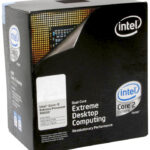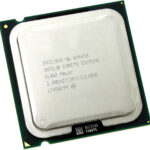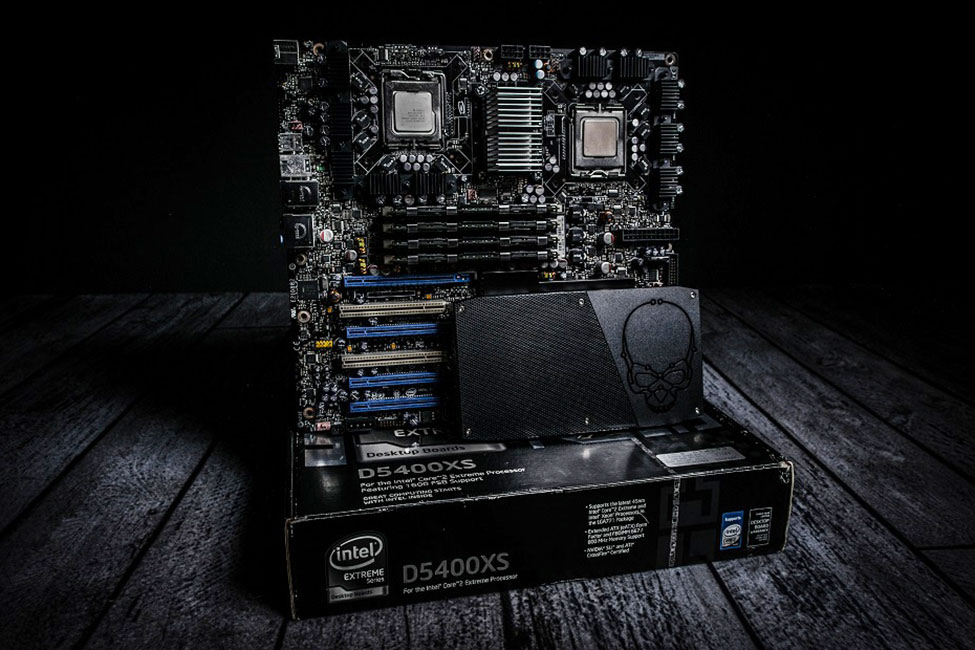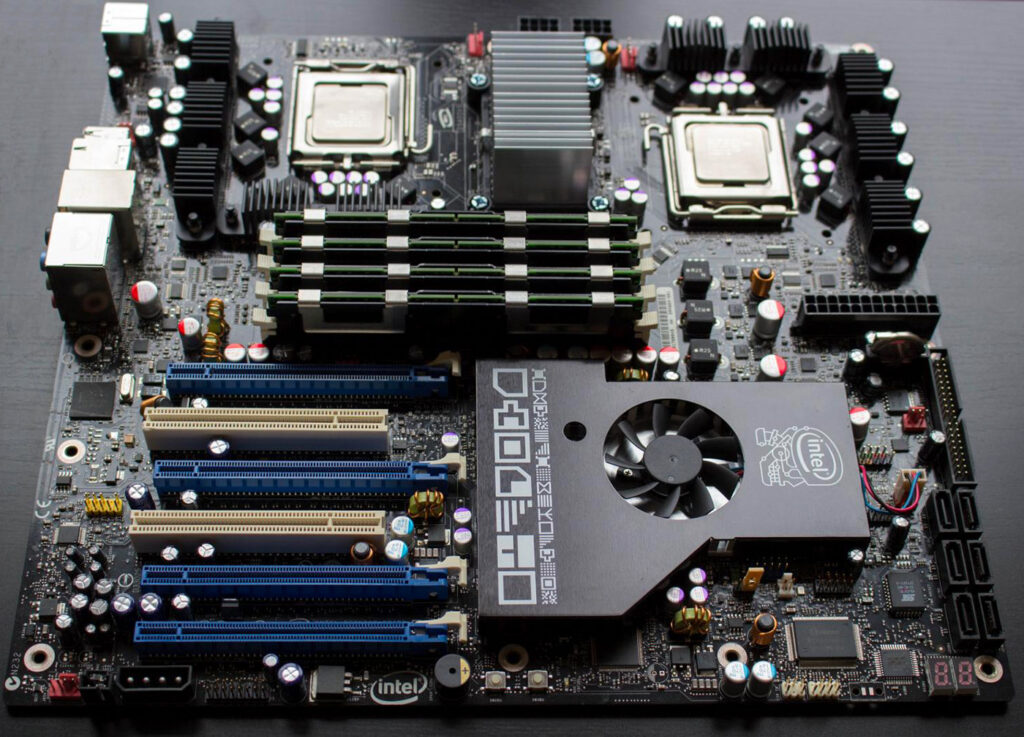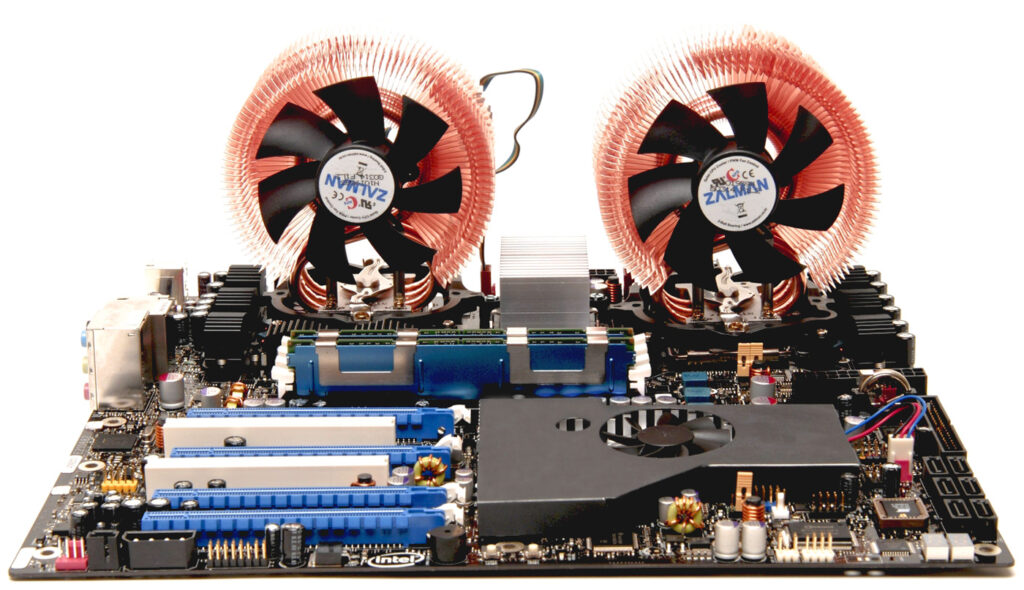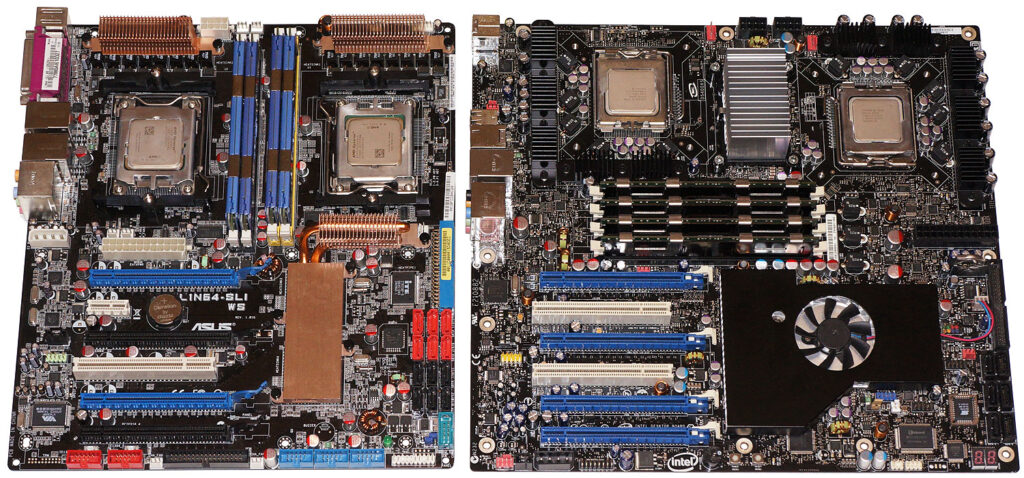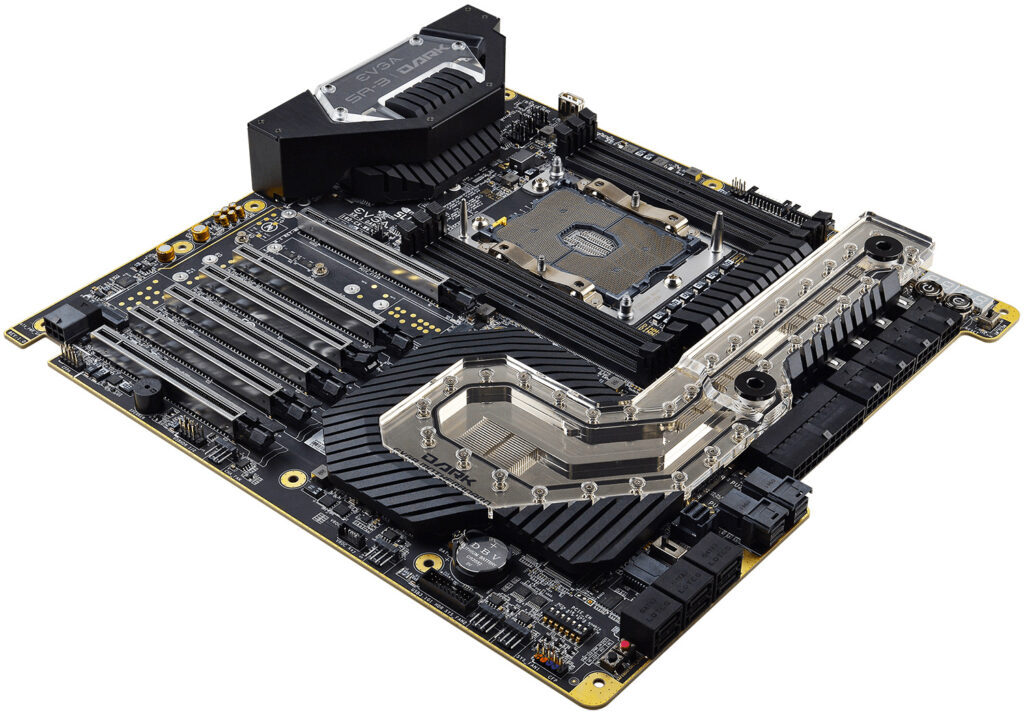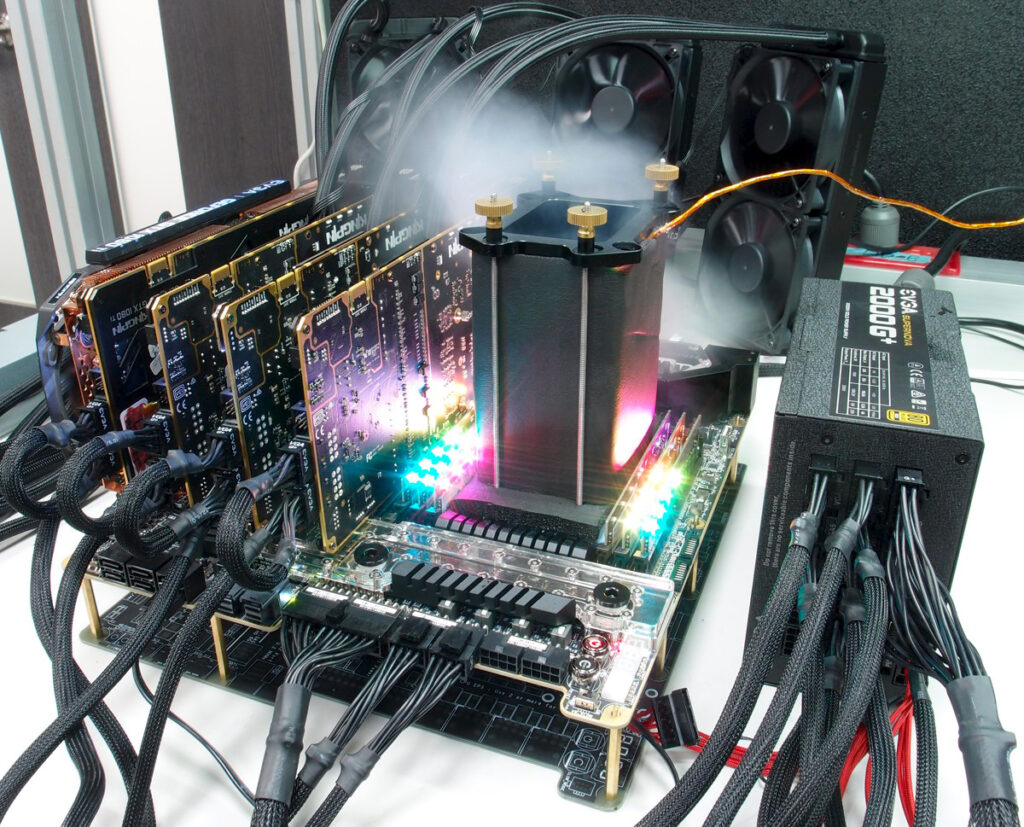The History of the SUPER HEDT x86 PC
Introduction
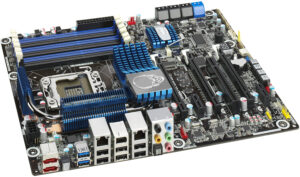 Last time we talked about the history of the development of high-end computers or High-End Desktop PC (HEDT). In the discussion of the article, some readers remembered motherboards that belonged to HEDT, but were one step higher, both in terms of their technical characteristics and in terms of the cost of ownership of the entire platform based on them. It is possible to name such very high-performance systems – Super HEDT, which often also had their own personal names, and we will talk about them this time.
Last time we talked about the history of the development of high-end computers or High-End Desktop PC (HEDT). In the discussion of the article, some readers remembered motherboards that belonged to HEDT, but were one step higher, both in terms of their technical characteristics and in terms of the cost of ownership of the entire platform based on them. It is possible to name such very high-performance systems – Super HEDT, which often also had their own personal names, and we will talk about them this time.
Last time, the date of the appearance of Intel processors for LGA1366 and the announcement of the first motherboards for them was taken as the beginning of the countdown for the announcement of the HEDT platform. This event happened in the fall of 2008. The reason for the appearance of such platforms was dictated by the decision of the main chipmaker to create two platforms: one for all consumers, and the second specifically for enthusiasts who are ready to get additional performance and new features for extra money that were not available (or needed) for owners of conventional desktop platforms. The logic of making such a decision is simple and logical, but with Super HEDT platforms things are somewhat different.
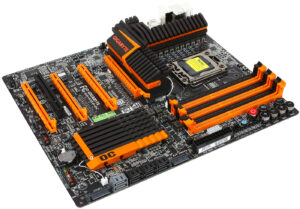 There may be several reasons for the emergence of such platforms. One of which is to show a competitor that we can do even it better and even faster, to make performance extremes, at the cost of incredible efforts of engineers and, as a result, an incredibly high final price for the end user. Although, for such systems, the price, although it plays an important role, is not a deterrent, because there will always be enthusiasts who are willing to pay as much as the manufacturer dictates to have the very best.
There may be several reasons for the emergence of such platforms. One of which is to show a competitor that we can do even it better and even faster, to make performance extremes, at the cost of incredible efforts of engineers and, as a result, an incredibly high final price for the end user. Although, for such systems, the price, although it plays an important role, is not a deterrent, because there will always be enthusiasts who are willing to pay as much as the manufacturer dictates to have the very best.
By announcing such a platform, the manufacturer can be sure that the fame and success of his Super HEDT platform will smoothly spill over to his other products, even in the budget segment, because if he is capable of producing a Super “miracle” of engineering, then all of his products, will also have the same properties as the miracle ones, only they will be slower performance and a reasonable price. Super HEDT aura and advertising will do their job and competitors will be forced to return from heaven to earth, because they will have nothing to answer.
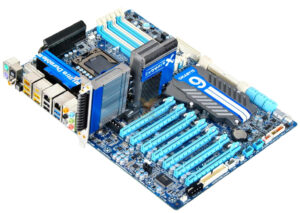 The second reason for the appearance of such systems may be for a diametrically opposite reason – when the manufacturer fails to defeat a competitor on his football field and the only way out is to continue the game somewhere in the orbit of the planet, where the opponent will definitely not fly. Your own personal field – your own rules, even if the price of such a decision will also be cosmically high and beyond the reach of most earthlings. But they will talk about such a decision, though not for long, but long enough to lift you up onto the podium of media fame for a brief time..
The second reason for the appearance of such systems may be for a diametrically opposite reason – when the manufacturer fails to defeat a competitor on his football field and the only way out is to continue the game somewhere in the orbit of the planet, where the opponent will definitely not fly. Your own personal field – your own rules, even if the price of such a decision will also be cosmically high and beyond the reach of most earthlings. But they will talk about such a decision, though not for long, but long enough to lift you up onto the podium of media fame for a brief time..
And oddly enough, the first Super HEDT system recalled in this article will be the system that was born according to the second, more pessimistic scenario. Has anyone already guessed it?
To find the answer to this question, we will have to go back in time to the very end of November 2006. At this time, the golden years of AMD had already passed, the dominance of its extremely successful Socket 939 and the fastest single-core processors, which included the various Athlon 64 FX’s, had ended. With the introduction of new revolutionary Intel Core processors to the market, AMD had been cornered with its Socket AM2. The market turned towards multi-core, and AMD had nothing to boast of in performance per core. The appearance of the first quad-core Intel Core 2 Quad processors completely deprived AMD of any chance for worthy competition.
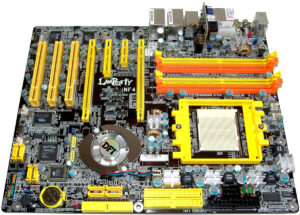 If you look at the range of processors available on the market in the fall of 2006, AMD had different Athlon 64 X2’s, manufactured according on a rather outdated 90 nm process technology, the fastest model was the Athlon 64 X2, 5200+ with a real clock speed of 2.6 GHz and a processor for ” green” enthusiasts, the Athlon 64 FX-62 with a clock frequency of 2.8 GHz and a recommended price of $1031. At this time, Intel was selling the Core 2 Duo E6700 with a clock frequency of 2.66 GHz and a recommended price of $530 and a dual-core flagship Core 2 Extreme X6800 at 2.93 GHz, 1066 MHz FSB and 4MB of L2 cache. The cost of all Extreme Editions then was $999. But in November, Intel got its first 4-core processors based on the “Kentsfield” core. The Intel Core 2 Extreme QX6700 was clocked at 2.66 GHz and became the first halo chip, and then more “popular” models followed to conquer the market. The “Kentsfield” core itself was not an honest “quad-core”, it consisted of two Core 2 Duo cores placed on the same substrate. (Hello to all chiplets, and a separate AMD Ryzen) Well, AMD did not go well with its Phenoms, but something had to be done, at least for the sake of media noise.
If you look at the range of processors available on the market in the fall of 2006, AMD had different Athlon 64 X2’s, manufactured according on a rather outdated 90 nm process technology, the fastest model was the Athlon 64 X2, 5200+ with a real clock speed of 2.6 GHz and a processor for ” green” enthusiasts, the Athlon 64 FX-62 with a clock frequency of 2.8 GHz and a recommended price of $1031. At this time, Intel was selling the Core 2 Duo E6700 with a clock frequency of 2.66 GHz and a recommended price of $530 and a dual-core flagship Core 2 Extreme X6800 at 2.93 GHz, 1066 MHz FSB and 4MB of L2 cache. The cost of all Extreme Editions then was $999. But in November, Intel got its first 4-core processors based on the “Kentsfield” core. The Intel Core 2 Extreme QX6700 was clocked at 2.66 GHz and became the first halo chip, and then more “popular” models followed to conquer the market. The “Kentsfield” core itself was not an honest “quad-core”, it consisted of two Core 2 Duo cores placed on the same substrate. (Hello to all chiplets, and a separate AMD Ryzen) Well, AMD did not go well with its Phenoms, but something had to be done, at least for the sake of media noise.
The recipe for such an answer is always the same: let’s take our server platform, embellish it a little, adapt the BIOS for enthusiasts, and give the server processor a free multiplier. We will make the number of sockets more than one and the answer is ready. But server systems have a lot of limitations, besides, some of them are hardware-based and cannot be adapted to desktop standards. But in such cases, there is no time for compromises, it is better to sacrifice functionality, performance will not suffer much from this.
AMD Quadfather
AMD’s “Godfather” the Super HEDT “Quadfather” platform from AMD became the answer to the competitor’s quad-core disgrace. It was based on a server Socket LGA1207 (Socket F) in the amount of two pieces, a pair of chipsets from Nvidia, the nForce 570 SLI, non-registered DDR2-SDRAM memory and a pair of processors belonging to the already outdated AMD K8 microarchitecture with Windsor process cores, manufactured the old 90 nm process. Asus did not refuse to make a special motherboard for this platform – ASUS L1N64-SLI WS, and AMD generously endowed users with three processor models. These were three models of the AMD Athlon 64 FX processor of the 70 series.
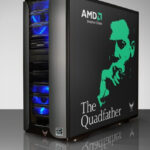 The processors were sold in pairs at prices ranging from $600 for a pair of low-end models (FX-70) to $1,000 for a pair of top-end Athlon 64 FX-74 clocked at exactly 3 GHz. From the 90 nm production technology, AMD was forced to squeeze out almost everything so that the processors could work normally at a frequency of 3 GHz. The selection did its job, because there was no need to produce these models in large quantities. The final result turned out to be very hot, absolutely everything was heated in this platform.
The processors were sold in pairs at prices ranging from $600 for a pair of low-end models (FX-70) to $1,000 for a pair of top-end Athlon 64 FX-74 clocked at exactly 3 GHz. From the 90 nm production technology, AMD was forced to squeeze out almost everything so that the processors could work normally at a frequency of 3 GHz. The selection did its job, because there was no need to produce these models in large quantities. The final result turned out to be very hot, absolutely everything was heated in this platform.
The total TDP of two processors was equal to 250 W, while one 4-core “Kentsfield” also consumed quite a bit, but it was only 130 W. A pair of Nvidia nForce 570 SLI chipsets also had a very hot temper, the motherboard’s VRM was also not easy, so each of the 3 radiators was equipped with a turbine cooler that pleased its owner with the sound of a jet fighter taking off.
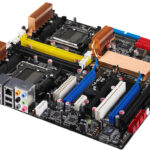 From an industrial design point of view, the board looks amazing. The E-ATX form factor managed to accommodate four PCI-Express x16 slots, working according to the x16 x8 x16 x8 formula, and one PCI slot. Twelve second generation SATA connectors, one IDE connector for connecting two IDE devices, ten USB 2.0 ports and a lot of copper heatsinks. At that time, the cost of motherboards did not fly into space, and this miracle of engineering thought could be easily purchased for $400. A couple more processors + $1,000, a powerful power supply, 4 or 8 GB of RAM, a couple or three top-end video cards… As a result, prices for finished assemblies started at $3,000 and reached 5 or even 7 thousand.
From an industrial design point of view, the board looks amazing. The E-ATX form factor managed to accommodate four PCI-Express x16 slots, working according to the x16 x8 x16 x8 formula, and one PCI slot. Twelve second generation SATA connectors, one IDE connector for connecting two IDE devices, ten USB 2.0 ports and a lot of copper heatsinks. At that time, the cost of motherboards did not fly into space, and this miracle of engineering thought could be easily purchased for $400. A couple more processors + $1,000, a powerful power supply, 4 or 8 GB of RAM, a couple or three top-end video cards… As a result, prices for finished assemblies started at $3,000 and reached 5 or even 7 thousand.
 But according to the few tests of those years, in most rounds, a single-socket processor from Intel won, but sometimes “Quadfather” still managed to break away due to a higher clock frequency, but Intel processors could easily add a few more hundred megahertz due to overclocking, and for AMD the extra 200 MHz was a very severe test. The power consumption of the two competing platforms differed by a decent amount, although for such systems this factor does not play any role at all.
But according to the few tests of those years, in most rounds, a single-socket processor from Intel won, but sometimes “Quadfather” still managed to break away due to a higher clock frequency, but Intel processors could easily add a few more hundred megahertz due to overclocking, and for AMD the extra 200 MHz was a very severe test. The power consumption of the two competing platforms differed by a decent amount, although for such systems this factor does not play any role at all.
AMD managed to get some attention as a result of such a PR-action, but was this platform worth the money? In my opinion – no, if AMD were ahead in all tests, then undoubtedly – yes, but despite this, this platform entered computer history. And from the point of view of modern overclocking, this is already a very, very interesting sample for various tests and experiments. You can still find it on sale now, but for this you need to make a little effort.
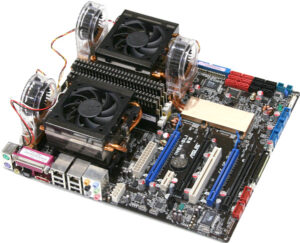 Intel did not expect such a number from AMD with the “Godfather” and even despite the fact that it was in the lead, its pride was clearly hurt, because it did not have any two-socket “super-duper” system for crazy money, while AMD did. You begin to see that ‘pride’ was driving marketing, more then engineering, or need, yet the margins on these Super HEDT systems were quite good, good enough to make it well worth the efforts.
Intel did not expect such a number from AMD with the “Godfather” and even despite the fact that it was in the lead, its pride was clearly hurt, because it did not have any two-socket “super-duper” system for crazy money, while AMD did. You begin to see that ‘pride’ was driving marketing, more then engineering, or need, yet the margins on these Super HEDT systems were quite good, good enough to make it well worth the efforts.
Then came the year 2007, in which in the spring Intel raised the clock speed of its new flagship Core 2 Extreme QX6800 to 2.93 GHz, and in the summer the 3 GHz Core 2 Extreme QX6850 came out with a 1333MHz FSB, equal to that of the “Godfather”. And finally, the long-awaited November is here! AMD presents two of its first 4-core processor models: Phenom X4 9500 and Phenom X4 9600. The first had a clock speed of 2.2 GHz, and the second 2.3 GHz. Both processors were installed in Socket AM2+, had 4 cores and were manufactured on the new 65 nm process.
To which Intel responded in kind, in the same month, with the release of a quad-core Core 2 Extreme QX9650 based on the “Yorkfield” processor core, where all 4 cores run at 3 GHz, the FSB frequency is 1333 MHz and in addition to everything, the processor has a very “fat” L2 cache with a total volume of 12 MB. This monster was produced according to the 45 nm process technology. AMD is very far behind Intel at this point in time. But there was still a debt for Intel, and at the very beginning of 2008 it overtook AMD in the form of the first Super HEDT system from Intel.
Intel Skulltrail
In February 2008, Intel introduced the monster, which gave its own name – Skulltrail. It was a platform where performance was taken to the extreme, as was the final cost of the entire system. This platform was based on two extreme processors that replaced the Core 2 Extreme QX9650, but in the LGA771 form factor. Quad-core Core 2 Extreme QX9775 cost from $1500 apiece and ran at a frequency of 3.2 GHz, the system bus frequency was 1600 MHz, and had 12 MB of L2 cache. We had everything in front of us, too, the Yorkfield core, but adapted to a different (server) socket. A pair of these processors was installed in a special Intel D5400XS motherboard, with two LGA771 sockets.
Intel did not develop a motherboard from scratch, it took one of its server solutions with the Intel 5400 chipset as a basis and adapted it to the needs of wealthy enthusiasts. For enthusiasts, the motherboard has Power and Reset buttons, an indicator of POST codes, and most importantly, holes have been made suitable for installing cooling systems from a conventional LGA775 desktop platform. Four PCI-Express slots along with two PCI added to the overall picture.
Thanks to the presence of two NVIDIA nForce 100 SLI switch chips, it was possible to install 4 video cards. The total number of PCI-Express lanes was 32, but Nvidia artificially limited support for only two video cards in SLI mode. 3Way-SLI and Quad-SLI were not officially supported, but there were no restrictions for AMD with its CrossFireX. You could find such a board on sale for about $600-650, which by modern standards does not seem like such a large amount, but against the background of good middlings of those years, costing up to $200, this amount already seemed something fantastic.
In Skulltrail, in addition to the Core 2 Extreme QX9775 for $1500 each, it was possible to install Intel Xeon 5400 series server processors, but they did not have a free multiplier at their disposal, although the board could well afford to overclock a Xeon pair via the system bus, for which the BIOS of the motherboard there were corresponding options for raising voltages, ranging from processor cores, chipset and ending with RAM. The top Intel Xeon X5482, similar in characteristics to the Core 2 Extreme QX9775, except for the free multiplier, was estimated by Intel to sell for $1299, so when assembling the highest-performance and ultimate assembly of that time, there was no question of any savings.
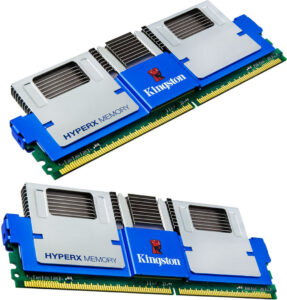 The processing power of all 8 cores for that time was simply impressive. But like any system, even the Skulltrail had its downsides. The first and most important is the use of specific server RAM of the DDR2 FB-DIMM (Fully Buffered) standard. Such RAM was suitable only for server systems and had high latency, as well as high cost and high heat. Having installed 4 memory modules in 4 slots, the enthusiast got at his disposal a 4-channel RAM subsystem, which actually lost to high-speed dual-channel DDR2-SDRAM memory and, moreover, lagged behind the latest DDR3-SDRAM, which began to appear on motherboards with an LGA775 socket with Intel P45 and x38 chipsets.
The processing power of all 8 cores for that time was simply impressive. But like any system, even the Skulltrail had its downsides. The first and most important is the use of specific server RAM of the DDR2 FB-DIMM (Fully Buffered) standard. Such RAM was suitable only for server systems and had high latency, as well as high cost and high heat. Having installed 4 memory modules in 4 slots, the enthusiast got at his disposal a 4-channel RAM subsystem, which actually lost to high-speed dual-channel DDR2-SDRAM memory and, moreover, lagged behind the latest DDR3-SDRAM, which began to appear on motherboards with an LGA775 socket with Intel P45 and x38 chipsets.
As a result, as now, mainstream systems outperformed HEDT in classic games, due to better balance and games using fewer high-frequency processor cores. But if you play strategy games with thousands of units on the map or chess, then Skulltrail took its prize, as in all other tasks related to rendering, coding and performing complex mathematical calculations and so on.
In the rest of the minuses, you can write down the power consumption of the entire system, heating and cost. Although these are conventions for Super HEDT systems, nevertheless, the TDP of one processor was 150 W, DDR2 FB-DIMM also had an increased power consumption, relative to conventional DDR2-SDRRAM, and heating up to 60+ C is a common occurrence for it. A couple of top-end graphics cards in SLI also added to the power consumption, and at the end, Intel recommended using a 1KW power supply for their system.
As for the cost of such assemblies, it started from $6000 and ended with 10-12 thousand US dollars. They were produced by such well-known brands as: Digital Storm, Falcon Northwest, Maingear, Puget Systems, Velocity Micro, Vigor Gaming, Voodoo PC and others. For example, a build from Maingear called the Ephex Skulltrail cost a modest $8995. It included the Intel Skulltrail platform itself, two Core 2 Extreme QX9775 processors overclocked to 4 GHz, 4 GB of DDR2 FB-DIMM RAM with a frequency of 800 MHz, a pair of 10k rpm Western Digital Raptor HDDs (before SSDs were ‘affordable’), combined in a RAID 0 array, a pair of two ATI Radeon HD 3870 X2 chipset video cards or a pair of Nvidia GeForce 8800 Ultra. The cooling system was based on a custom CBO that cooled both the CPU and the GPU. A 1200 W Silverstone DA1200 power supply was responsible for powering the entire assembly and heating your office.
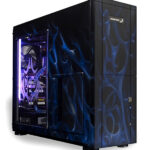 /The owner of such a Super-HEDT PC could still enjoy all the benefits of having 8 real processor cores for a long time, but progress did not stand still and in the spring of 2010 wealthy enthusiasts again had a chance to try something incredibly new, this time even more breathtaking in terms of performance.
/The owner of such a Super-HEDT PC could still enjoy all the benefits of having 8 real processor cores for a long time, but progress did not stand still and in the spring of 2010 wealthy enthusiasts again had a chance to try something incredibly new, this time even more breathtaking in terms of performance.
EVGA Classified Super Record 2
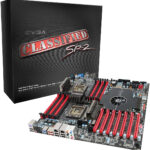 This time EVGA made a gift to all overclockers and enthusiasts by releasing the EVGA Classified Super Record 2 (SR-2) motherboard with two LGA1366 processor sockets. The full development of the High-End Desktop PC or HEDT just started with the LGA1366 socket. The LGA1366 platform itself was already distinguished by its cost compared to the usual desktop platform, but EVGA, thanks to its board, raised it to the skies. The cost of the board itself, which was based on a server solution modified and redesigned for the needs of overclockers based on the Intel 5520 system logic, was at least $600. EVGA really embraced the overclocker and extreme market, even having special edition video cards in honor of various famous extreme overclockers.
This time EVGA made a gift to all overclockers and enthusiasts by releasing the EVGA Classified Super Record 2 (SR-2) motherboard with two LGA1366 processor sockets. The full development of the High-End Desktop PC or HEDT just started with the LGA1366 socket. The LGA1366 platform itself was already distinguished by its cost compared to the usual desktop platform, but EVGA, thanks to its board, raised it to the skies. The cost of the board itself, which was based on a server solution modified and redesigned for the needs of overclockers based on the Intel 5520 system logic, was at least $600. EVGA really embraced the overclocker and extreme market, even having special edition video cards in honor of various famous extreme overclockers.
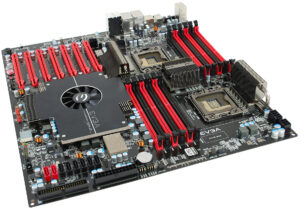 Unlike the Intel Skulltrail, this board did not have any pronounced weaknesses. The EVGA Classified SR-2 was compatible with the Intel Xeon 5500 and 5600 series server processors. The 5500 series of processors included processors with the Nehalem microarchitecture, which contained up to 4 cores and were produced at 45 nm tech. process, as well as more advanced processors with Westmere microarchitecture, which were produced using even smaller tech. process – 32 nm. and had six cores, which in total with Hyper Threading technology for the entire platform gave 12 cores or 24 threads. To conquer the World Records, it was necessary to purchase a couple of top Xeons, the price per piece of which was $1663. In March 2010, the top model was the Xeon X5680 with a clock frequency of 3.33 GHz, and in the following 2011, its place was taken by an even higher-frequency model with the X5690 index, already operating at a frequency of 3.46 GHz.
Unlike the Intel Skulltrail, this board did not have any pronounced weaknesses. The EVGA Classified SR-2 was compatible with the Intel Xeon 5500 and 5600 series server processors. The 5500 series of processors included processors with the Nehalem microarchitecture, which contained up to 4 cores and were produced at 45 nm tech. process, as well as more advanced processors with Westmere microarchitecture, which were produced using even smaller tech. process – 32 nm. and had six cores, which in total with Hyper Threading technology for the entire platform gave 12 cores or 24 threads. To conquer the World Records, it was necessary to purchase a couple of top Xeons, the price per piece of which was $1663. In March 2010, the top model was the Xeon X5680 with a clock frequency of 3.33 GHz, and in the following 2011, its place was taken by an even higher-frequency model with the X5690 index, already operating at a frequency of 3.46 GHz.
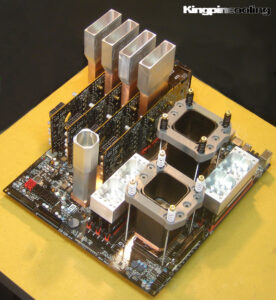 The memory subsystem was represented by twelve slots, where it was possible to officially install 48 GB of DDR3-SDRAM memory, and not officially 96 GB, with a clock frequency of up to 1866 MHz. The three-channel mode of operation of the RAM helped to get good performance, in tasks that required an active exchange of data between the memory and the processor. Seven 2nd gen PCI-express x16 slots made it possible to install quartets of Nvidia or AMD video cards with a working formula x16 + x16 + x16 + x16, and a few more slots remained free. The board was not deprived of USB and SATA interfaces, their number was even in excess.
The memory subsystem was represented by twelve slots, where it was possible to officially install 48 GB of DDR3-SDRAM memory, and not officially 96 GB, with a clock frequency of up to 1866 MHz. The three-channel mode of operation of the RAM helped to get good performance, in tasks that required an active exchange of data between the memory and the processor. Seven 2nd gen PCI-express x16 slots made it possible to install quartets of Nvidia or AMD video cards with a working formula x16 + x16 + x16 + x16, and a few more slots remained free. The board was not deprived of USB and SATA interfaces, their number was even in excess.
For the needs of overclockers, the board implemented the Power and Reset buttons familiar to everyone, the POST code indicator, the measurement points for all the main voltages with a multimeter, from the Vcore of both processors, to the voltages of the RAM modules, VTT, north and south bridges, and so on. The EVGA SR-2 had three BIOS chips, one of which was removable. This made it possible, in case of unsuccessful flashing, to roll back to the BIOS backup copy, simply by switching the switch on the motherboard to the desired position (1-2-3).
The EVGA Classified SR-2 had some interesting jumpers in its arsenal that helped overclockers with extreme overclocking. One of them “X-Cool” was responsible for the stability of the system when using liquid nitrogen, when the processor temperature dropped below -50C, and the other JOH and I-Limit were responsible for the stability of the system during intensive overclocking. The board also supported the connection of an external wired control panel – EVBot, with which it was possible to change voltages on the fly and overclock a pair of Xeons via the system bus. Overclockers were not deprived of the software component either, with the help of a special proprietary utility EVGA E-LEET Tuning Utility, all manipulations related to overclocking could be carried out directly on the Windows desktop in real time.
With the help of air cooling, a pair of six-core processors could be overclocked to 4.3 – 4.5 GHz, and liquid nitrogen did make it possible to get 6 GHz at the peak for all cores. Famous overclocker EVGA – Vince “Kingpin” Lucido set more than one World record in 2D and 3D benchmarks using this board using a quartet of video cards, but he got this equipment free of charge, and all other enthusiasts had to part with numbers comparable to the cost of the Intel Skulltrail. As for the prices in this segment, they are as high and stable as the very performance of such Super HEDT systems.
EVGA Classified SR-X
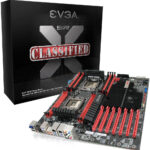 It took two years for the EVGA Classified SR-2 to be replaced by the new 2-socket EVGA Classified SR-X board. But the previous success could not be repeated, although the board turned out to match the previous one in all its capabilities and characteristics. This time, two LGA2011 V1 sockets were placed on one PCB, which supported Intel Xeon E5 server processors with Sandy Bridge and Ivy Bridge processor cores. The motherboard was based on the Intel C606 server chipset, twelve DDR3-SDRAM memory slots worked in 4-channel mode and officially supported 96 GB. Like the previous model, the board had seven PCI-Express x16 slots, but of the third generation, thanks to which the simultaneous operation of three video cards was supported, and if a fourth was added, it shared the common PCI-E x16 line in half with the third.
It took two years for the EVGA Classified SR-2 to be replaced by the new 2-socket EVGA Classified SR-X board. But the previous success could not be repeated, although the board turned out to match the previous one in all its capabilities and characteristics. This time, two LGA2011 V1 sockets were placed on one PCB, which supported Intel Xeon E5 server processors with Sandy Bridge and Ivy Bridge processor cores. The motherboard was based on the Intel C606 server chipset, twelve DDR3-SDRAM memory slots worked in 4-channel mode and officially supported 96 GB. Like the previous model, the board had seven PCI-Express x16 slots, but of the third generation, thanks to which the simultaneous operation of three video cards was supported, and if a fourth was added, it shared the common PCI-E x16 line in half with the third.
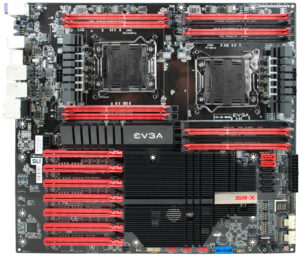 Overclocking options such as the presence of Power, Reset and Clear CMOS buttons and a diagnostic LED indicator, as well as the presence of test points for measuring voltage, have already been habitually observed. All innovations and technologies were aimed at fine tuning and overclocking, but Intel removed the existing possibility of overclocking Xeon server processors via the bus, and the maximum that enthusiasts could count on was a modest BCLK range within 100 – 110 MHz. But, compared to the previous Super HEDT platform, the SR-X supported 10 core processors, which in total with Hyper Threading allowed 40 processing threads. The supported Xeon processors did not have an unlocked multiplier and the frequency of multi-core processors was usually 3GHz, which was clearly not enough to build a productive gaming system. The recommended cost of EVGA Classified SR-X was $650, but the lack of overclocking has reduced the popularity of this solution to a minimum.
Overclocking options such as the presence of Power, Reset and Clear CMOS buttons and a diagnostic LED indicator, as well as the presence of test points for measuring voltage, have already been habitually observed. All innovations and technologies were aimed at fine tuning and overclocking, but Intel removed the existing possibility of overclocking Xeon server processors via the bus, and the maximum that enthusiasts could count on was a modest BCLK range within 100 – 110 MHz. But, compared to the previous Super HEDT platform, the SR-X supported 10 core processors, which in total with Hyper Threading allowed 40 processing threads. The supported Xeon processors did not have an unlocked multiplier and the frequency of multi-core processors was usually 3GHz, which was clearly not enough to build a productive gaming system. The recommended cost of EVGA Classified SR-X was $650, but the lack of overclocking has reduced the popularity of this solution to a minimum.
It seemed that everything was over, the race in the premium HEDT sector was over, the cost of Hi-End desktop and HEDT solutions reached figures comparable, and sometimes even superior, to the best uncompromising Super HEDT solutions of the past. The cost of individual motherboards with one socket has exceeded $500-600, and some even ask for $1000. Until recently, among the usual line of HEDT processors, the cost of some instances (Intel Core i9-7980XE, 9980XE) reached two thousand dollars, and it’s better not to mention the cost of video cards in recent years (though this has been pushed largely by crypto mining rather then HEDT use), therefore, according to the total amounts of Hi-End Desktop systems and HEDT, received parity with systems similar to Intel Skulltrail and AMD Quadfather.
Intel Xeon W-3175X
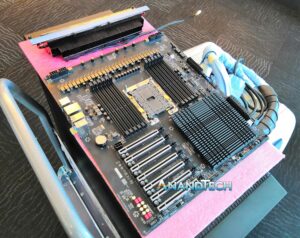 At the beginning of 2019, another precedent arose when AMD began to take the lead in the performance race, and Intel was caught playing catch up. The maximum that Intel could offer then to wealthy enthusiasts was 18 cores on the Skylake microarchitecture, produced using a 14+++ nm process. And AMD had its 2nd gen Threadripper with 16, 24 and even 32 cores, manufactured on a 12nm process technology. Intel needed its own “Godfather” and the decision on its appearance was soon made.
At the beginning of 2019, another precedent arose when AMD began to take the lead in the performance race, and Intel was caught playing catch up. The maximum that Intel could offer then to wealthy enthusiasts was 18 cores on the Skylake microarchitecture, produced using a 14+++ nm process. And AMD had its 2nd gen Threadripper with 16, 24 and even 32 cores, manufactured on a 12nm process technology. Intel needed its own “Godfather” and the decision on its appearance was soon made.
For the first time, a new platform for the elite was shown at Computex 2018, where on an unknown board, an unknown Intel server processor with 28 cores, under unknown circumstances of its cooling, worked at a clock frequency of 5 GHz, operating with 56 threads and scored more than 7 thousand points in the Cinebench R15 benchmark , which was higher than the results of configurations with a pair of EPYC 7601 or Xeon 8170. The informational reason for the application for success was received. In the news and in the discussions under them, readers looked at the photos and wondered about this miracle of configuration. Later it turned out that the cooling system was represented by a high-performance chiller HAILEA HC-1000B (735 W), and the processor consumed more than half a kilowatt of energy. As new information emerged, the picture of the new Super HEDT system loomed clearer. And by the time the finished components went to retail, it was already known what they had to deal with.
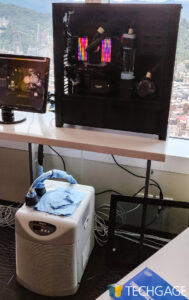 To fight in the high-performance HEDT segment with AMD, Intel went to unprecedented measures. The most productive 28-core Xeon model in the LGA3647 version was granted a free multiplier and clock frequencies of all cores were tightened. So the only processor on which all hopes were placed was the Intel Xeon W-3175X. The nominal frequency of the cores of this Skylake generation was 3.1 GHz, in boost a pair of cores was able to hit a frequency of 4.3 GHz. The free multiplier made it possible to raise the bar even higher, thus solving the problem of launching demanding games that love not only the number of cores, but also their clock speed.
To fight in the high-performance HEDT segment with AMD, Intel went to unprecedented measures. The most productive 28-core Xeon model in the LGA3647 version was granted a free multiplier and clock frequencies of all cores were tightened. So the only processor on which all hopes were placed was the Intel Xeon W-3175X. The nominal frequency of the cores of this Skylake generation was 3.1 GHz, in boost a pair of cores was able to hit a frequency of 4.3 GHz. The free multiplier made it possible to raise the bar even higher, thus solving the problem of launching demanding games that love not only the number of cores, but also their clock speed.
A similar model for the server segment without the ability to set a free multiplier, but with the ability to be installed in multi-socket configurations, was estimated at over 10 thousand US dollars. Therefore, Intel had to make such a gift, because if the cost of one processor was 10 thousand dollars or more, then such a processor would look ridiculous, if only because the AMD Ryzen Threadripper were cheaper, much cheaper. But at the end, the retail price of a single processor was around $4,000, and it’s good that there was only one socket on the motherboard of such a processor!
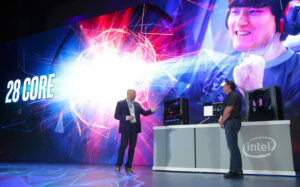 This time, Intel did not develop the design of the motherboard itself, but gave this prerogative to Asus, and subsequently there were two more eminent motherboard manufacturers who decided to test their strength, since the development and design of a motherboard for such a processor was not a trivial matter. Obviously, no profit was expected from the release of such boards, the development was more expensive, but the image component from the fact that we, too, “can,” covered all the costs and risks. Its always nice to be able to shift engineering costs to the marketing departments budget afterall!
This time, Intel did not develop the design of the motherboard itself, but gave this prerogative to Asus, and subsequently there were two more eminent motherboard manufacturers who decided to test their strength, since the development and design of a motherboard for such a processor was not a trivial matter. Obviously, no profit was expected from the release of such boards, the development was more expensive, but the image component from the fact that we, too, “can,” covered all the costs and risks. Its always nice to be able to shift engineering costs to the marketing departments budget afterall!
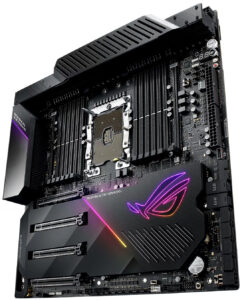 At the time of the release of the Intel Xeon W-3175X processor, the only motherboard available was the ASUS ROG Dominus Extreme, which was based on the Intel C621 server chipset. The board was equipped with twelve slots for DDR4 memory modules with a frequency of up to 4200 MHz and a total capacity of up to 192 GB. The processor supported 6-channel access to RAM. The power subsystem included 32 phases at once, which spoke of the very hot temper of the system itself.
At the time of the release of the Intel Xeon W-3175X processor, the only motherboard available was the ASUS ROG Dominus Extreme, which was based on the Intel C621 server chipset. The board was equipped with twelve slots for DDR4 memory modules with a frequency of up to 4200 MHz and a total capacity of up to 192 GB. The processor supported 6-channel access to RAM. The power subsystem included 32 phases at once, which spoke of the very hot temper of the system itself.
On the PCB of the motherboard, you can find two 24-pin ATX power connectors for connecting two power supplies at once, because during extreme overclocking, the 28-core monster consumed more than 1 kW of energy. The set of expansion slots included four PCI Express 3.0 x16 slots that could split the 48 processor lanes into x16/x16/x16 or x16/x8/x16/x8 configurations, and support for Nvidia 4 Way-Sli and AMD CrossFireX was also announced.
The motherboard measures 14 x 14 inches (36 x 36 cm). Thus, the motherboard does not fall under any fixed format such as E-ATX or the SSI EEB server standard. But, ASUS has positioned the holes in the board’s PCB in such a way that the motherboard can be installed in the E-ATX mounts – provided that the case is wide enough to install it. Otherwise, this motherboard has everything for overclocking, tuning and monitoring, as in any top-end Asus motherboard related to the ROG series that is familiar to everyone.
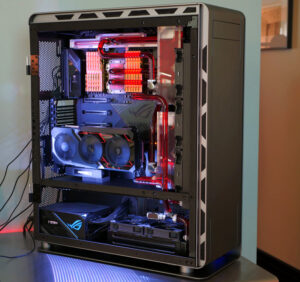 For modding enthusiasts, there is a built-in RGB backlight and an informational 1.77” OLED display. There are eight SATA III ports, two U.2 connectors, and four M.2 slots for connecting storage devices. The latter are placed on two ROG DIMM.2 boards and are equipped with aluminum heatsinks. Network interfaces are represented by a 10 Gbs adapter from Aquantia model AQC-107, gigabit Intel I219-LM, Wi-Fi is handled by a Intel AC-9260 standard 802.11ac with Bluetooth 5.0 support. The cost of the board was in the region of 2000-2200 US dollars, which, together with a processor for $4000 and a set of RAM for one and a half to two thousand dollars, made this system accessible only to selected enthusiasts. Ready uncompromising configurations cost similar to a new car, a pretty nice one.
For modding enthusiasts, there is a built-in RGB backlight and an informational 1.77” OLED display. There are eight SATA III ports, two U.2 connectors, and four M.2 slots for connecting storage devices. The latter are placed on two ROG DIMM.2 boards and are equipped with aluminum heatsinks. Network interfaces are represented by a 10 Gbs adapter from Aquantia model AQC-107, gigabit Intel I219-LM, Wi-Fi is handled by a Intel AC-9260 standard 802.11ac with Bluetooth 5.0 support. The cost of the board was in the region of 2000-2200 US dollars, which, together with a processor for $4000 and a set of RAM for one and a half to two thousand dollars, made this system accessible only to selected enthusiasts. Ready uncompromising configurations cost similar to a new car, a pretty nice one.
Despite this cost, the board had one very serious drawback, known as the “cold start” problem, when the board does not start and the error code “code 00” is displayed. It takes 2-3 attempts to start the system, and this is due to an engineering miscalculation by Asus engineers or simply a defect that came to light when the boards were already on sale. Problem boards have serial numbers beginning with K3xxxxx through K7xxxxx. This is due to one element located near the post-code indicator. If you heat this area with a hair dryer to 30 degrees or just hold your finger on it, the board starts up safely.
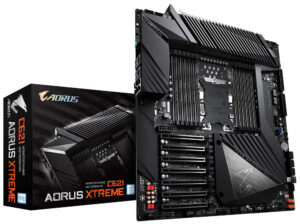 After Asus, Gigabyte released its board for the only processor with a free multiplier – the C621 Aorus Xtreme model. In appearance, it is very similar to the product from Asus, had similar hardware characteristics, but instead of 4 PCI-Express x16 slots, it has seven. I did not find any intelligible information on the account of its any distinctive qualities on the network, except perhaps for reports of problems with the software component.
After Asus, Gigabyte released its board for the only processor with a free multiplier – the C621 Aorus Xtreme model. In appearance, it is very similar to the product from Asus, had similar hardware characteristics, but instead of 4 PCI-Express x16 slots, it has seven. I did not find any intelligible information on the account of its any distinctive qualities on the network, except perhaps for reports of problems with the software component.
Time passed, the end of 2019 was approaching, and finally, in the last days of December, the news appeared on the EVGA website about the start of accepting applications (yes you had to apply to be able to buy these boards, like a Ferrari) for a new legend that enthusiasts have been waiting for almost a year – EVGA SR-3 Dark! The announcement of the board was postponed several times, but finally it took place and by making a modest $1799.99 in the form of an advance payment, the first lucky owners could hold this masterpiece of engineering in their hands starting from January 13, 2020. And for everyone else who did not manage to make an advance payment, they had to pay $ 200 more or $ 1999.95
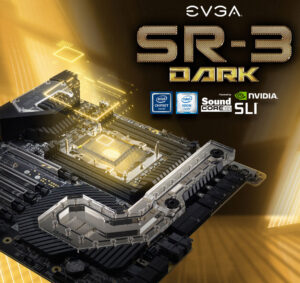 It is often EVGA’s policy to delay the release of their products to some extent in order to study the competition and make their product even better, and this approach is quite justified. Take for example the previous HEDT flagship – EVGA x299 Dark for LGA2066. This board was released later than all manufacturers, when only the first models of Core-X 7-series processors were still available, but thanks to thoughtful circuitry and a solid margin of safety, EVGA did not re-release a new generation of boards for the 9th and 10th generation of processors, as other manufacturers did, they didn’t have the same VRM overheating issues that the first wave of motherboards had either. In a word, EVGA had the relevant experience, but in the case of the EVGA SR-3 Dark, there should not be any mistakes, like the ASUS ROG Dominus Extreme, and even more so the product from Gigabyte, because the reputation of the manufacturer was at stake.
It is often EVGA’s policy to delay the release of their products to some extent in order to study the competition and make their product even better, and this approach is quite justified. Take for example the previous HEDT flagship – EVGA x299 Dark for LGA2066. This board was released later than all manufacturers, when only the first models of Core-X 7-series processors were still available, but thanks to thoughtful circuitry and a solid margin of safety, EVGA did not re-release a new generation of boards for the 9th and 10th generation of processors, as other manufacturers did, they didn’t have the same VRM overheating issues that the first wave of motherboards had either. In a word, EVGA had the relevant experience, but in the case of the EVGA SR-3 Dark, there should not be any mistakes, like the ASUS ROG Dominus Extreme, and even more so the product from Gigabyte, because the reputation of the manufacturer was at stake.
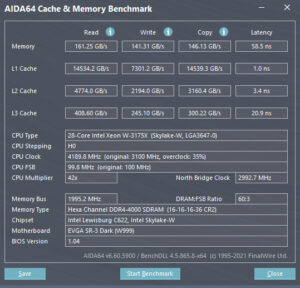 As a result, when the motherboard went on sale, it differed from previous motherboards and was distinguished by literally everything. The first thing that catches your eye is the size of the board, it became more compact and had an E-ATX size, which allowed it to be installed in almost any solid case. The board has 16 layers of PCB, which makes it not so easy to manufacture, this is also reflected in its weight. The socket and RAM slots, which became 6 instead of 12, were rotated 90 degrees. For a six-channel processor controller, 6 slots are quite enough, less pickups – higher and more stable overclocking, and this motherboard was created for conquering World records.
As a result, when the motherboard went on sale, it differed from previous motherboards and was distinguished by literally everything. The first thing that catches your eye is the size of the board, it became more compact and had an E-ATX size, which allowed it to be installed in almost any solid case. The board has 16 layers of PCB, which makes it not so easy to manufacture, this is also reflected in its weight. The socket and RAM slots, which became 6 instead of 12, were rotated 90 degrees. For a six-channel processor controller, 6 slots are quite enough, less pickups – higher and more stable overclocking, and this motherboard was created for conquering World records.
The SR-3 power system consists of 20 power phases (18 VCore, 1 VSA and 1 VCCIO) and three more are dedicated to powering the RAM. According to the manufacturer, the power system is capable of withstanding a load of 1200 watts. The board is powered from the main 24-pin connector, plus there are four more 8-pin connectors.
The VRM and chipset are cooled by a solid water block, where liquid flows through the water block from the power phases to the chipset. The VRM water block can be integrated into an existing CBO circuit. The board also has 6 PCI-Express 3.0 X16 slots, a pair of M.2 connectors and another pair of U.2 connectors for SSD drives, 6 SATA 3.0 6 Gbs ports and one Mini-SAS port that can be transformed into 4 SATA 3.0. Two M.2 slots and two U.2 ports are directly connected to the processor’s PCI-Express lanes. For gamers, the board has a good 5.1 channel sound codec powered by the Creative – Core3D Audio CA0132. And for network battles, you can find 3 Ethernet connectors on the board at once, 2 of which support a 10 Gbs connection. The USB ports are 8x USB 3.0, one USB 3.1 Type A and one USB 3.1 Type C.
Since the main task of this board is to set world records, in addition to the BIOS intended for these cases, the motherboard has three BIOS chips and various mechanical switches for its operation modes, which are necessary for active bench sessions.
Conclusion
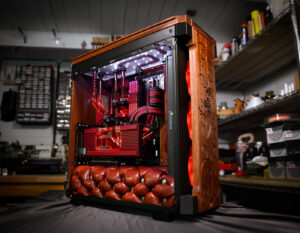 Super HEDT platforms, of course, deserve special respect, at least for the efforts of the engineers who developed them, they make you wonder and experience a sense of delight from their qualitative and quantitative characteristics. But to possess them at the time of their appearance on the market is not given to many, the price is too high. Although, in some cases, as practice shows, in some tasks such systems can easily lose to Hi-End desktops, in 99% this applies to games, but the owners of these systems are clearly not avid gamers and understand why they need them, although games on them also comfortable to play.
Super HEDT platforms, of course, deserve special respect, at least for the efforts of the engineers who developed them, they make you wonder and experience a sense of delight from their qualitative and quantitative characteristics. But to possess them at the time of their appearance on the market is not given to many, the price is too high. Although, in some cases, as practice shows, in some tasks such systems can easily lose to Hi-End desktops, in 99% this applies to games, but the owners of these systems are clearly not avid gamers and understand why they need them, although games on them also comfortable to play.
Over the years, such systems lose a lot of value and after 5 years four figures in dollars may be 10% of their original cost, but this is the price of progress, which is gaining momentum every year.
At the end of this year, the eternal opponents of the two opposing camps should present their new HEDT platforms, their quantitative characteristics already cause ambiguous feelings regarding the number of cores. Perhaps one of the parties will release a new Super HEDT platform, but we will find out about all this at the end of this outgoing year. In the meantime, it’s better for all fans of fast computer driving to start stashing money for a future upgrade, since new hardware will obviously cost a lot.
Article by max1024
Edited by CPU Shack


